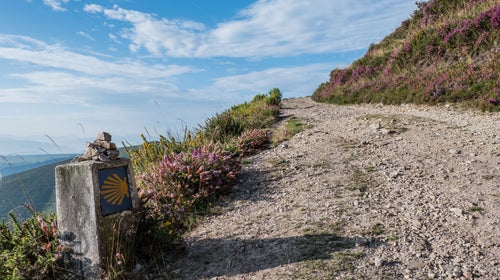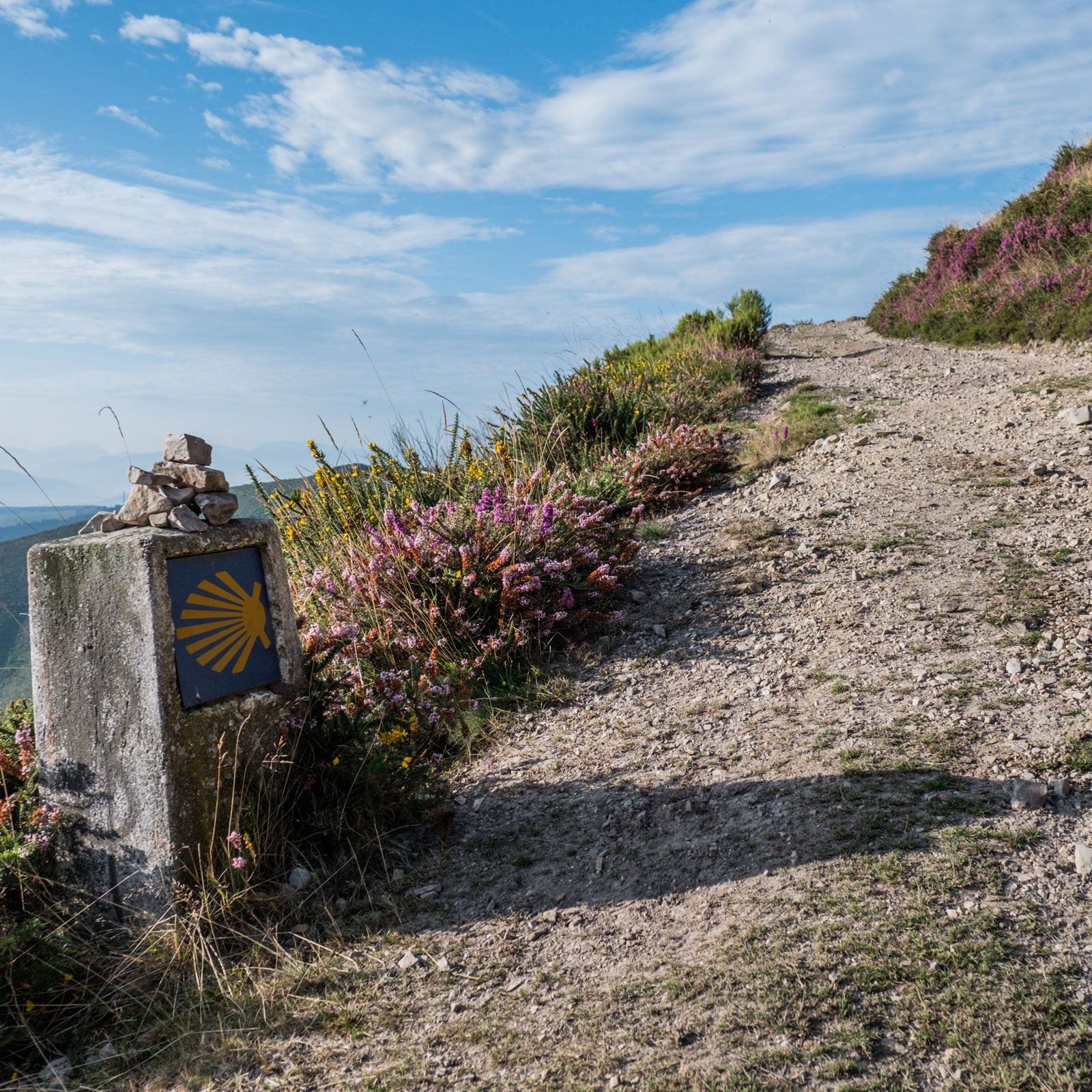A smoking silver thurible swooped through the gothic arches overhead, richly scented incense pouring from its sides. Eight priests in heavy robes acted as the counterweight, controlling a rope as thick as my forearm. I shuddered to think what might happen if the cord snapped, spilling 175 pounds of heated metal and 90 pounds of coal onto the crowd below
The hundred-year-old ritual taking place before me and the month-long walk I had taken to get there seemed like something out of a George R.R. Martin book. But this was the real-life ending to my trip down the Camino de Santiago, a Catholic pilgrimage that was Medieval Europe’s answer to the Appalachian Trail.
Today, believers make up a small proportion of people walking the Camino de Santiago. The vast majority of pilgrims are on their own recreational or spiritual quests. For me, a month-long hike sounded like an amazing challenge but an achievable one, too.
Being away from friends and family, work commitments, and an Internet connection gave me the time I needed to decompress and follow my thoughts to wherever they wanted to go; there’s a kind of spirituality in that, too. Like any other long-distance walk, there’s a physical and mental commitment to the task, a simple rhythm of daily needs to meet.
This modern take on pilgrimage is only getting more popular: The number of people walking the Camino Franc├ęs has jumped from under 10,000 in 1992 to over 190,000 in 2012. In 2023, roughly 442,000 people made the trek. Ready to join them? Start with our guide.
Walking the Camino de Santiago: A Brief History
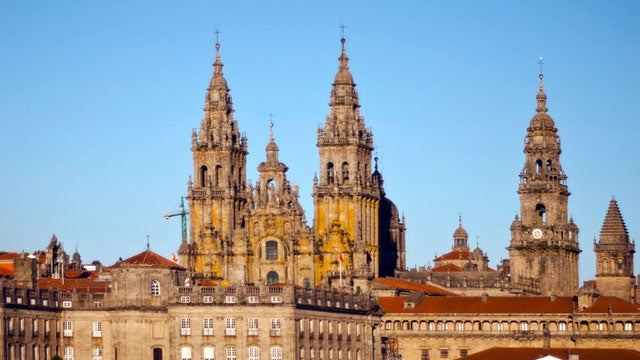
The focal point and namesake of the Camino de Santiago is the city of Santiago de Compostela, located in Spain’s far northwest. The city, where legend has it that the martyr St. James is buried, became a rallying point for Europeans fighting the Moors in the eighth century, after a shepherd claimed to have seen a bright light in the skies above.
During the Middle Ages, the Camino was responsible for the largest movement of people in Europe: millions of people, both rich and poor, made their way to Santiago de Compostela, where the pilgrim mass and certificate of pilgrimage ensured they would spend less time in purgatory. The route was nearly lost to history until the past couple of decades, when a growing body of literature around the Camino sparked a resurgence of interest in it from abroad.
When most people talk about “the Camino”, they’re . Also known as the Camino Franc├ęs (the French Way), this route starts at St. Jean Pied-du-Port in France, crosses the Pyrenees, and continues westwards across Spain about 60 miles south of the coast. It passes through Pamplona, Burgos, Leon, and a host of smaller towns and villages and is about 500 miles long, depending on how many detours you take.
While the walk itself is the main attraction today, that wasn’t always the case. In the Middle Ages, the whole idea was to arrive in the holy city of Santiago de Compostela, and you started at your own front door; there was no official “starting point”. Because it was safer for people to walk together, common routes were established, and many of the paths through other European countries converged in St. Jean.
But what if you lived in England? Or Portugal? Or Madrid? Traveling to France to start your pilgrimage there wouldn’t make sense. So many smaller routes were established by pilgrims making their way from their homes and are named accordingly: The Camino Portugu├ęs travels northwards through Portugal, while the Camino Ingl├ęs catered to English pilgrims who arrived on the north coast by boat. Today, as the French Route draws more and more tourists, many walkers are starting to rediscover these secondary paths.
Walking the Camino de Santiago: How to Prepare
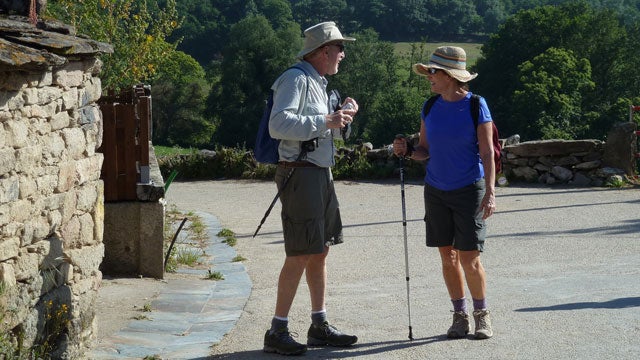
There are a plethora of guidebooks and online resources to help you plan your pilgrimage, but IÔÇÖm of the opinion that you should do the minimum amount of planning possible. If there’s any hike that’s worth improvising, the pilgrimage to Santiago de Compostela is it.
That said, it’s a good idea to bring a basic route guidebook, such as the ones . Have this posted to you before you start and use it to figure out what kind of pace you’ll have to set and what sights you want to see, based on the length of your trip.
Once you’re on the way, you’ll find this plan changes. You’ll meet some people you want to walk with for a few days; you’ll want to push yourself to do another few miles; you’ll decide it’s a perfect time to sit by the river and think about life. Unlike a backcountry hike, there’s enough infrastructure around that you don’t need to have every detail perfectly laid out.
There’s very little technical walking on the main Camino routesÔÇöyou’ll mostly be on well-maintained tracks or pavementÔÇöso you don’t need much backpacking experience. If you don’t hike much, get out and around your neighborhood for an hour each day, and take care to break in your shoes beforehand. If you don’t do a lot of walking, get out and about around your neighborhood for an hour or two each day. I always said my training for the Camino was the first week of the Camino: by the time you’ve pushed through those first five days, things become a lot easier.
The clothing and technical gear you’ll need for the Camino depends on what season you’re hiking in, but err on the lighter side. Your fully-packed bag, with a bit of food and a full water bottle, should weigh no more than 15 percent of your body weight, with a goal of 10 percent. For my 155-pound frame, I aimed for 22 pounds or less. Start with this list:
- A 30-40 liter backpack.
- Your credential, passport or valid ID, journal, and a pen in a waterproof bag. Bring a journal so you can add stamps and jot down notes.
- A water bottle of some kind. I like a two-liter Platypus with cap, which you can use on those days where it’s a long way between water stops.
- Toiletries. No make-up, but plenty of sunscreen and soap suitable for hand-washing clothes. If you can endure it, many men and women avoid shaving on the Camino to eliminate the weight of that gear.
- A small first-aid kit, including painkillers, antiseptic cream, bandages, blister plasters and a sterile needle to drain blisters. Pharmacies are easy to find, so you don’t need medical supplies for the whole way unless you rely on a particular prescription.
- Two t-shirts, two pairs of zip-off trousers, and three pairs of underpants and socks. Wash at your stops and dry overnight.
- Hiking layersÔÇöwhatever you need to stay warm and dry. Sometimes you might be walking over plains in 40-degree heat; a week later snow will start falling in the mountains. I recommend merino wool thermal underwear (top and bottom), a fleece top for warmth, a wind- and water-proof outer jacket and pants, and a pack cover to protect your things from the rain.
- I favor light, comfortable walking shoes or hiking sandals over boots for most of the Caminos, with the possible exception of the Primitivo. I always bring along a pair of flip-flops to allow my feet to breathe and dry after walking.
- As few electronics as you can bear. Bring a camera and a phone, but leave the laptops and iPads at home.
- Basic eating utensils. Most refugios and albergues have kitchens, but I’d recommend carrying a spork, sharp knife, lightweight plate, bowl and cup. It’s not uncommon to have someone spontaneously cook a communal meal, or pilgrims to all chip in and make something together.
Walking the Camino de Santiago: The Routes
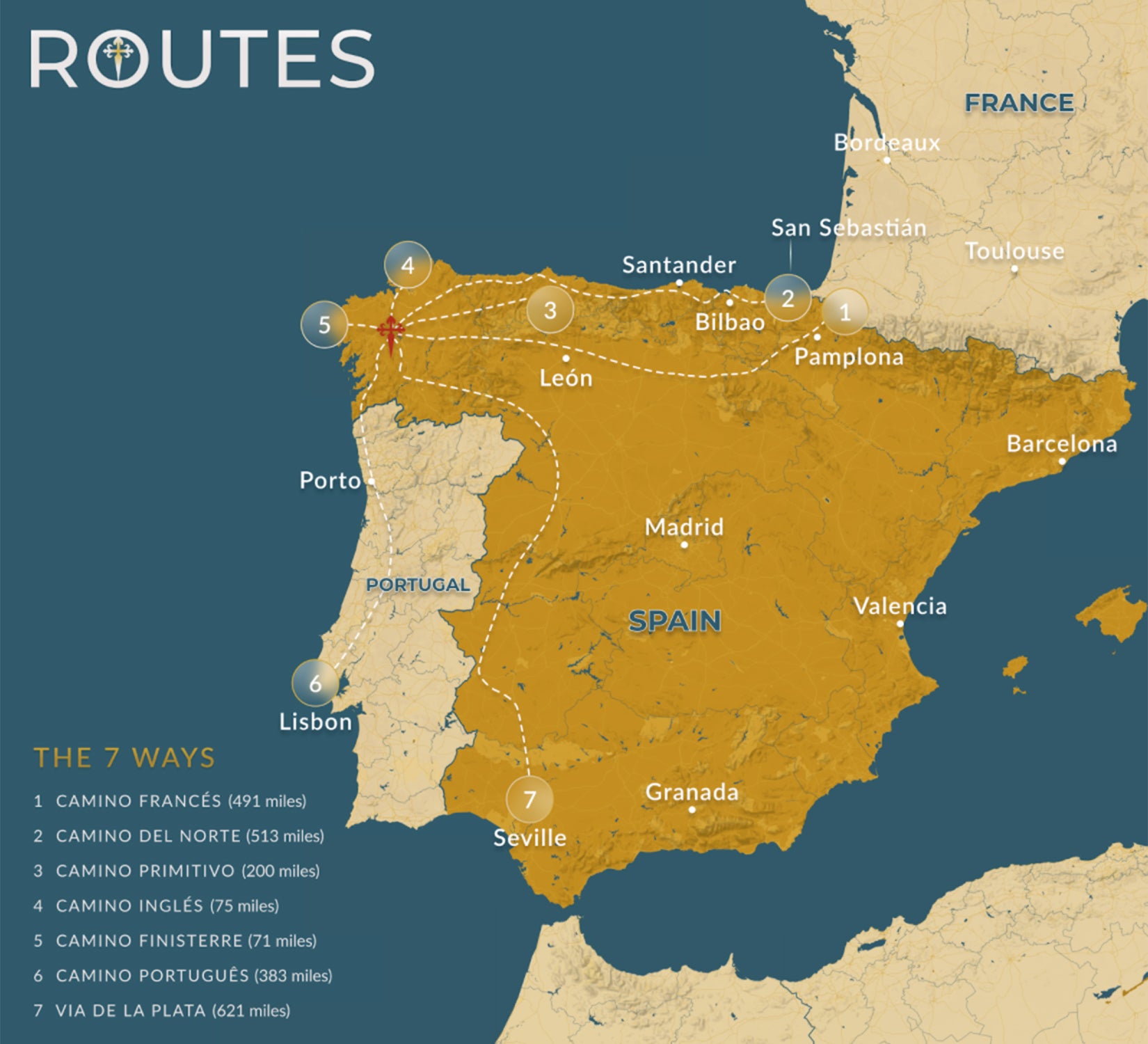
The network of Caminos crosses Europe, and you can follow a Way from Finland or Turkey. The possibilities are beyond the scope of this article, but these are the main routes.
Camino Franc├ęs (the French Way)
The Camino Franc├ęs is the most popular option for a reason: The varied scenery and good infrastructure mean that itÔÇÖs an enjoyable walk. Most of the routes from other parts of Europe converge in St Jean Pied-du-Port, which is where the Camino Franc├ęs officially starts.
Camino del Norte (the Northern Way)
Hugging the northern coast of Spain, this route starts in Ir├║n on the border with France and travels west through Bilbao, Santander, and Oviedo. The 510 miles of pathway will take about 35 days to complete, and though the distances between towns are reasonable, the sparse accommodations mean that you have to stick to a fairly rigid itinerary.
Camino Portugu├ęs (the Portuguese Way)
In contrast with many of the other routes, the Camino Portugu├ęs is relatively flat, without too many hills. It starts in Lisbon, passes through Porto and Pontevedra on its way north through Portugal, and is approximately 380 miles long. The infrastructure is reasonable, but much of the route takes you alongside motorways.
Via de la Plata
The “plata” in the Via de la Plata’s name comes from a corruption of an Arabic word that means “wide surfaced road.” In this sense, it’s well named, as most of the route follows an old Roman road north from Seville; if you’re interested in Roman history, this is the route for you. At 620 miles, it’s the longest route through Spain, and it passes through Merida, C├íceres, Salamanca, Zamora, and other cities.
Camino Ingl├ęs (the English Way)
English pilgrims arriving by boat from Britain started their walk at either La Coru├▒a or Ferrol, and the English Way is a Y-shaped route that can be started in either of these cities. The 75km from La Coru├▒a can be walked in three days, though you won’t earn a Compostela as it’s under 62 miles. From Ferrol, the 70-mile walk will take five days.
Camino Primitivo (the Original Route)
Oveido isn’t on the Camino Franc├ęs, but many pilgrims detour there to visit the city’s cathedral. The Camino Primitivo is the most direct route from Oviedo to Santiago (passing through Lugo), and it rejoins the Camino Franc├ęs about 40 miles from Santiago. The walk is about 180 miles long and is quite challenging, as it includes a fair amount of hill climbing, and the weather can be very erratic.
Camino de Finisterre (the Finisterre Way)
Instead of finishing their walk in Santiago, many pilgrims continue on to one of the westernmost points in Europe: Finisterre, whose name literally translates to “end of the world.” The route from Santiago to Finisterre adds 55 miles and is best walked in five stages, with an optional extra 18-mile walk to Muxia afterward. Organizations in Finisterre and Muxia both offer Compostelas to those who complete these routes.
Walking the Camino de Santiago: Talk the Talk
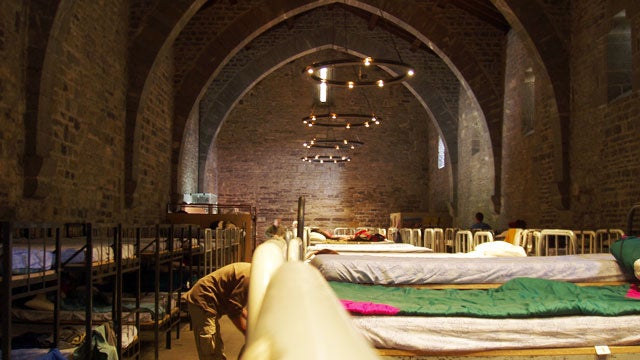
Everyone who walks the Camino should get familiar with the following Spanish terms:
A compostela is the “pilgrim certificate” you get at the end of the walk if you’ve completed 100 kilometers (about 62 miles) or more on foot. If you are not Catholic but did the Camino for ‘spiritual reasons, you can still get a Compostela. If you say your goals were non-spiritual, you get a rather plain certificate of completion.
Albergues and refugios are the pilgrim’s accommodation stops. Run by churches, town councils, non-profit organizations, and private for-profit groups, they provide cheap beds in dorm rooms, mattresses in church bell towers, or hotel-like rooms with prices starting at five euros a night.
A credential is the ‘pilgrim passport’ issued by various Camino-friendly organizations. Each albergue or refugio has its own stamp, which you’ll receive each night. You need a credential to stay in pilgrim accommodations and a complete record of stamps to get your Compostela. Arrange to have one posted to you in advance if you’re not starting at a popular stepping-off point. Accommodations are first come, first served, with preference given first to walkers, then horse-riders, then cyclists.
Craig Martin has been traveling full-time since February 2006 and has walked three Caminos in that time: the Camino Franc├ęs, the Via de la Plata, and the Camino Ingl├ęs. A Kiwi, he loves wine and is addicted to the new. Find more of his travels on his or on X.
